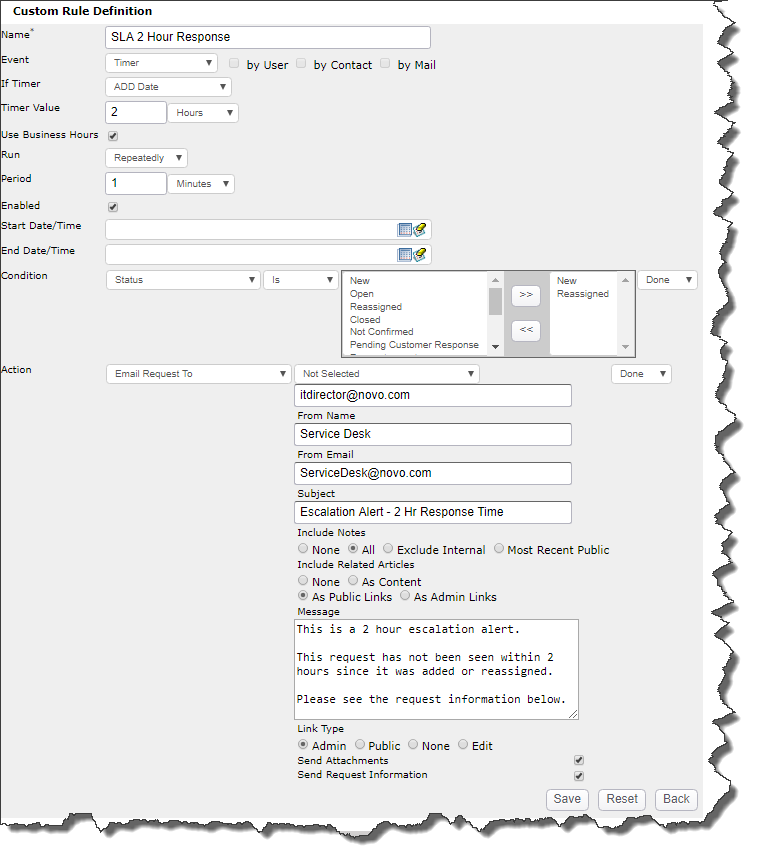Request Manager Timer Rules
Purpose: Enabling Timer Rules
Prerequisites: Novo Request Management
Configuration Steps:
There are 3 steps to enabling and using Request Timer rules:
- Create a Timer Rule
- Consider the Screenshot below:

- To create a Timer Rule...
- Set the Event Type to Timer
- Set the "If Timer" value. The options are ADD Date, EDIT Date, ASSIGN Date, COMPLETE Date, DUE Date and Initial Response Date.
- Set the "Timer Value". Add a numeric value into the text field and select a unit of time measurement. The options are Seconds, Minutes, Hours & Days. This relates to the If Timer value to form a statement like "If NOW is at least 1 second greater than the ADD Date...".
- Decide whether the Rule will incorporate business hours into the time calculation. If Business Hours are enabled in the rule and Business Hours are set to 9 hours; 8:00 am to 5:00 pm, and the Timer Value extends to beyond the closing time as set in Business hours, the Rule will wait until the sum of the business hours and the Timer Value are reached before triggering.
- Set the Run value. Options are Once or Repeatedly. This allows you to determine that a rule will run only once per Request (i.e. a one-time notification) or to continually run against the same Request (like a nagging alarm clock)
- Set the Period - If the Run value is set to Repeatedly, this value will determine how often the rule will run.
- Edit the runtimerudr.bat batch file on the web server to match your Virtual Directory path. This file is found in the Novo app's file system; (i.e. C:\Program Files\Novo\NovoScripts\) Below is the default runtimerudr.bat file. The line with wget.exe is the run command:
rem This is the bat file for executing Timer Custom Rules
rem
rem Replace %1 with the virtual path to the Novo site.
rem i.e. wget.exe -q http://localhost/novo/runtime/runtimerudr.asp
rem
rem remove '-q' and add a pause statement at the end of this bat to troubleshoot
rem remove 'del runtimerudr.as*' to enable feedback files
wget.exe -q %1/runtime/runtimerudr.asp
del runtimerudr.as*
- The last step is to schedule the runtimerudr.bat batch file. Use the Server Manager in Windows to schedule a task to run the runtimerudr.bat file periodically (for example, 1–5 minutes) so it checks whether the Timer Condition for triggering an Action has been met. (See the sub articles below this article for more information on creating Scheduled Tasks.)
What happens now? ....
The correctly formatted timer rule should trigger for requests that meet the conditions at the prescribed interval set in the scheduled task.
However, when a rule doesn't trigger, there are several possible points of failure that may or may not be self evident. We've listed most of them below:
- Check that the Rule is Enabled and that the Conditions and Actions are verifiable.
- Ensure that the conditions are actually met.
- Ensure the Admin account that the scheduled task is running under has sufficient privilages to run the task. Also check the password. If it was changed after the rule was setup, the task will not run.
- If the Novo app is setup to use the Active Directory plugin, it's likely that anonymous access has been disabled for the site. In this case, the runtimerudr.bat can't access the runtime/runtimerudr.asp file. Enabling Anonymous access for just the Runtime folder in IIS will solve this issue.
Sub Articles
 Create a Scheduled Task to Run Custom Timer Rules (Windows Server 2003)
Create a Scheduled Task to Run Custom Timer Rules (Windows Server 2003)